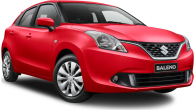I bet most people would struggle to name even three Kia Picanto rivals.
“The… uh… Mirage? They still sell that, right?” is the response I’d expect from most people. Maybe you’d throw in the Fiat 500 and, if you’re (for some reason) a microcar aficionado, you’d also point out there’s something called the MG3 still on sale, too.
Suzuki even recently pulled its uninspired Celerio from sale to add to Australia’s microcar graveyard next to the Nissan Micra, Volkswagen up! and Holden Spark.
Somehow though, the Picanto not only thrives, it’s multiplying with this new GT-Line variant popping up. So how can Kia justify adding another variant in this ever-contracting light car segment? And, is it worth the extra dosh? I spent a weekend finding out.

Saturday

Wait. Rewind for a second, because on Friday night I punished the GT-Line by loading it up with myself, three burly mates and one scrawny mate, then proceeded to drive it up a hill for 10 minutes. It looked about as ridiculous as it sounds, but I was honestly a little surprised at how well the 62kW 1.25-litre four-cylinder handled itself.
It hardly struggled with the extra weight. Some quick maths calculated the human cargo as close to, if not over the car’s 435kg max payload. It made me realise how easily you could unconsciously exceed that number with passengers, or luggage, or a combination of both.
Getting back to Saturday, the sunny weather and a casual drive through Sydney’s Balmain gave me some time to appreciate how fit-for purpose in the city this little car is.

The GT-Line comes in at an extra $1600 over the standard Picanto S auto, for a total of $17,290 (before on-road costs) and most of that money disappears into the GT-Line’s aesthetic touches.
It’s a smart move. The only competitor moving reasonable units outside of the fleet-friendly Mitsubishi Mirage ($14,250) is the Fiat 500 ($18,140), and that’s because of its timeless style.
The GT-Line’s vibe looks decidedly toward the future with aggressive edges and harsh lines complimented by ‘go-fast’ red highlights. While looks are always subjective, it still presents a viable alternative for those not enamoured with the ever-retro Fiat 500.
Objectively, the style-focused bits come with a few problems. As you’d imagine, the 16-inch alloys create a fair bit of road noise inside the cabin and the aggressive bodykit on the front is quite low causing it to scrape on just about every driveway.

Nice value-adds include the LED DRL clusters (which are as bright if not brighter than the halogen headlamps to the point where I forgot to turn them on at night), and electric folding mirrors with LED indicators.
Inside, it’s almost easy to forget exactly how small (and cheap) the Picanto is. There’s leagues of headroom above my 182cm frame, a full-size steering wheel, most of the switchgear out of much larger Kia models, and most impressively, the 7.0-inch touchscreen that’s becoming a nice standard across Kia’s range.
Fiat’s 500 also scores a 7.0-inch touchscreen, but the simplicity, brilliant layout and instant touch response of Kia’s user interface is tough to top. It also has Apple CarPlay (which worked flawlessly for me) and Android Auto.

The GT-Line package spices it up with some gloss-black finishes as well as faux leather seats, wheel and gearknob which all look and feel pretty great.
The only real irk I could think of in the cabin was the lack of room for my legs to comfortably rest for long periods, but in a car this size what do you expect?
Cabin practicality is also impressive for a car this size with four decent cupholders for front occupants and surprisingly, a centre armrest storage console, albeit a tiny one.

Combined with the storage alcove underneath the air-conditioning controls, it makes up for the lack of a glove box.
Sunday
My Sunday required a grocery shop and a freeway stint; convenient tests for the Picanto’s diminutive engine and limited dimensions.
First up, the grocery shop. The Picanto lays claim to the largest boot in the segment at 255 litres. It smashes the Fiat 500 which only has 182 litres and just pips the Mirage’s 235 litres.

It was more than sufficient for our weekly shop, but this car is hardly the best option for something like the airport run. Here’s the thing though – with the seats down the Picanto balloons out to 1010 litres of storage. That’s massive. For perspective, it’s even bigger than the Kia Rio when its seats are down.

Later in the day we went to visit some relatives on the other side of one of Sydney’s signature driving experiences: the M2. Often microcars with sub-80kW drivetrains can be particularly abysmal outside low-speed city settings, so this was a good opportunity to put it to the test.
Thankfully, the Picanto proved more than capable. The performance won’t surprise you, or set any benchmarks, but is more than adequate at freeway speed. Overtaking takes a little extra encouragement if you’re used to something with a 2.0-litre engine, although this car's road-holding betrays its size, and inspires confidence.
There are a few noticeable drawbacks. The little 1.25-litre low-tech engine is loud when pushed (a common Kia trope) and road noise is particularly gnarly courtesy of the 16-inch alloys.
The biggest disappointment was the fuel usage. At the end of my drive week the trip computer was returning a ridiculous 8.0L/100km which, to my surprise, is not far off Kia’s ‘urban’ fuel estimate of 7.9L/100km.

The worst part of this equation is that overseas, the Picanto is available with a 1.0-litre three-cylinder turbo which I expect would be more fit-for-task (and potentially more fun) in a car this size.
Safety-wise the Picanto is pretty impressive despite its four-star (out of five) ANCAP safety rating. The headline act is Auto Emergency Braking (AEB) and Forward Collision Warning System (FCWS) joining the regular slew of airbags and electronic stability assistance, which is nice on a car of this size and price.
Of all the microcars, the Picanto is the only one currently tested to the more stringent ANCAP standards introduced last year. The Fiat 500’s five-star rating dates from a decade ago, for example, and neither the 500 or the Mitsubishi Mirage feature AEB.

The Picanto can also claim warranty victory over those competitors by a significant margin. It carries Kia’s across-the-range seven-year/unlimited km shtick, compared to the 500’s lacklustre three year/150,000km coverage and the Mirage’s five year/100,000km offering.
All said and done, it's also worth considering that you can choose from a manual Kia Rio S or automatic(!) versions of the Honda Jazz VTi or Mazda2 for $300 less. All three are a size category up with more powerful engines...
Kia Picanto 2018: GT-Line
| Engine Type | Inline 4, 1.2L |
|---|---|
| Fuel Type | Unleaded Petrol |
| Fuel Efficiency | 5.8L/100km (combined) |
| Seating | 5 |
| Price From | $10,450 - $14,300 |
| Safety Rating |
|
Verdict
The standard Picanto is already one of the most compelling options in the microcar bracket, but the GT-Line adds some much-needed spice. It’s an excellent piece of design that feels right at home in the city, and a genuine stylistic alternative to the classic looks of the Fiat 500.
That said, be aware of how close the pricing brings it to hatchbacks a size up like the Rio, Honda Jazz or Mazda2 and the minor inconveniences brought by some of the GT-Line specific features.
Would you consider a Picanto over something a size up like the Rio? Tell us what you think in the comments below.
Pricing Guides



.jpg)
.jpg)




































_0.jpg)
.jpg)

.jpg)

